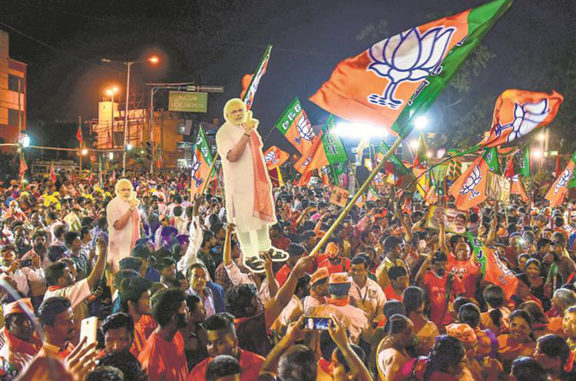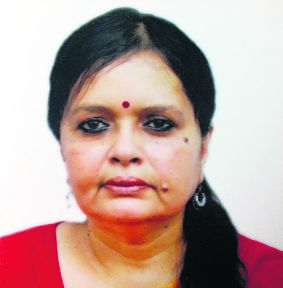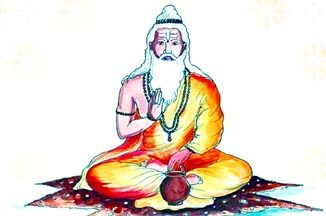

“Barring stray individuals, the core team remained unquestioningly loyal to the BJP through thick and thin. But the BJP’s recent enlargement and the induction of defectors from the Congress and regional parties etched their own fault lines. Added to this trend is the over-centralization of authority in identifiable power centers ensconced in Delhi which ride roughshod over the regions and the provincial satraps who werelaw unto themselves in the years when the nucleus was less strong.”
The tension between adhering to the RSS’s ideology and executing its divisive agenda and maintaining the power balance among a motley group of new inductees is one aspect of the New BJP.
The BJP has reasons to applaud and raise a toast to the success that came its way over the past seven years. The party’s website commemorates every milestone there is to celebrate. The BJP is the world’s largest party with 11 crore members, it rules at the Centre and over 18 states and union territories autonomously or in conjunction with allies, and has an unassailable grip over Parliament with 301 MPs in the 543-member Lok Sabha and 95 in the 245-member Rajya Sabha. With its rapid spread in the east and the north-east, the BJP has shed the tag of a party confined to the north and west of India. The south stands like a parapet against the unbridled expansion and the core beliefs enshrined in the BJP’s versions of nationalism and Hinduism.
Power carries a price tag despite generously rewarding the BJP. The cost entailed in maintaining and retaining defectors from the other parties — variously labelled as imports, turncoats, opportunists and weathervanes — is enormous. These are men and women who did not enter the BJP to embrace its ideology and imbibe the RSS’s bible. Their entry was a derivative of the party’s rise to a pole position where it held out the promise of a supreme patron handing out the loaves and fishes of power in much the way the Congress did in the decades gone by. There are two significant differences: the BJP was birthed by an ideologically motivated RSS, albeit out of expediency, when the Sangh needed political and parliamentary presence to lobby in crises and was part of a large family with equally ambitious progenies desirous of sharing power. On the other hand, the Congress spawned off-springs such as the Sewa Dal and the National Students’ Union of India that were always subservient to the parent. Second, the BJP or the Bharatiya Jana Sangh in its previous incarnation was on the political periphery until 1989 but the party organization was put together by dedicated founders who never swerved from the original political objectives and built a corps of workers, initially drawn from urban India, with the RSS’s help. Barring stray individuals, the core team remained unquestioningly loyal to the BJP through thick and thin. But the BJP’s recent enlargement and the large-scale induction of defectors from the Congress and regional parties etched their own fault lines. Added to this trend is the over-centralization of authority in identifiable power centers ensconced in Delhi which ride roughshod over the regions and the provincial satraps who were law unto themselves in the years when the nucleus was less strong.
A recent manifestation of the post-2014 features was in the leadership changeover in Uttarakhand, seven months before the assembly elections. The BJP anointed its third chief minister in four years. The first, Trivendra Singh Rawat, went out on account of his ‘unpopular’ decisions, one of which upset the powerful Hindu clergy. His successor, Tirath Singh Rawat, a Lok Sabha MP, had to quit ostensibly because he could not meet the deadline set for his election to the legislature. The view from inside the BJP was that the leadership was afraid for Rawat to contest a by poll in case he lost. If this reasoning is even partially true, it shows that despite the Congress’s failure to step up to the plate, the BJP is unsure about its prospects of returning to power. The choice for the third incumbent fell on a relatively younger Pushkar Singh Dhami, who like his peers in Himachal Pradesh and Goa, Jai Ram Thakur and Pramod Sawant, enters through the by now established route of the ABVP and the Bharatiya Janata Yuva Morcha. If demography were a determinant, nothing explains why the leaders could not have chosen the 45-year-old Dhami over the senior Rawats in the first place. Except that Uttarakhand has a line-up of CM aspirants, consisting of the BJP’s originals as well as the migrants who are reportedly miffed at being passed over thrice and could work against the official candidates in their districts in the elections. Over to another state, Tripura, that was trumpeted and showcased as a bang-up win in 2018 after the Left Front government was ousted, because the event marked the victory of ‘nationalism’ over ‘communism’. Two years hence, the BJP government, led by Biplab Kumar Deb of RSS provenance, was up against intra-party dissensions led by seven legislators, all from the Congress and the Trinamool Congress (TMC). Before the elections, the BJP lacked a viable functioning organization and candidates. However, realizing the groundswell of anger against the Left Front government, the BJP pressed its traditional attributes, like campaigning and propaganda dissemination, to advantage and channelized popular disenchantment into an offensive against the former CM, Manik Sarkar. The Congress and the TMC were ineffective counters. Seeing the wind blow in the BJP’s favor, their leaders and rank-and-file switched allegiance and filled in the human resources vacuum. However, under Deb, the trust deficit between the originals and the outlanders never closed. They were mutually suspicious to the extent that Sudip Roy Burman, a former Congressman who became a minister, was dropped for allegedly “conspiring” against the CM.
In Madhya Pradesh, when the BJP candidate was convincingly defeated by the Congress nominee in the Damoh Assembly by poll in May, the axe fell on Jayant Malaiya, a former BJP minister and a heavyweight at that, on the suspicion of sabotage. Rahul Lodhi, the candidate, came to the BJP from the Congress in the en masse defections that precipitated the downfall of the Kamal Nath government. In this instance, a BJP old-timer paid the price for allegedly getting back at a Congress defector.
Goa, Karnataka and Uttar Pradesh are the other states that exemplify a system stressed out by the pulls and pressures of power and possibly, of overreaching its ambitions. The tension between adhering to the RSS’s ideology and executing its divisive agenda and maintaining the power balance among a motley group of new inductees is one aspect of the New BJP. Undergirding the unwieldy growth is a powerful and cohesive center in the hands of Prime Minister Narendra Modi and Home Minister Amit Shah who so far have demonstrated an uncanny ability to hold together the contradictions. It’s not just about enforcing ‘discipline’.
(The author is a senior journalist)





Be the first to comment